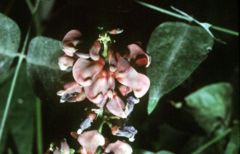Apios americana
| Apios americana subsp. var. | ||||||||||||||||||||||||||||||||||||||||||||||||||||||||
|---|---|---|---|---|---|---|---|---|---|---|---|---|---|---|---|---|---|---|---|---|---|---|---|---|---|---|---|---|---|---|---|---|---|---|---|---|---|---|---|---|---|---|---|---|---|---|---|---|---|---|---|---|---|---|---|---|

|
|
| ||||||||||||||||||||||||||||||||||||||||||||||||||||||
| ||||||||||||||||||||||||||||||||||||||||||||||||||||||||
Apios americana, sometimes called the hog peanut, potato bean, or groundnut (but not to be confused with other plants sometimes known by the name groundnut) is a perennial vine native to eastern North America, and bears edible beans and large edible tubers. It grows to 3-4 m long, with pinnate leaves 8-15 cm long with 5-7 leaflets. The flowers are red-brown to purple, produced in dense racemes. The fruit is a legume (pod) 6-12 cm long.
The tubers are crunchy and nutritious, with a high content of starch and especially protein. The plant was one of the most important food plants of pre-European North America, and is now being developed for domestication.
| Standard Cyclopedia of Horticulture |
|---|
|
Apios tuberosa, Moench. Groundnut. Wild Bean. Four to 8 ft., climbing over bushes: root bearing strings of edible tubers, 1-2 in. long: lfts. 5-7, ovate-lanceolate: fls fragrant, chocolate-brown, the standard very broad and turned back, the keel long, incurved and scythe-shaped. July, Aug.—Common in low grounds and swamps. The fr. often fails to mature. Prop, by the tubers. 2-4 of which should be planted together at a depth of 3-4 in.; also, by seeds. Grows well in the wild border, in any loose, rich soil. Under these conditions, the plant covers a trellis or other support in a comparatively short time. Dry tubers offered by seedsmen are likely to start slowly. The brown of the fls. is a very unusual color in hardy herbs. Likely to become a weed in rockeries and wild gardens.
|
Cultivation
Propagation
Pests and diseases
Varieties
Gallery
-
photo 1
-
photo 2
-
photo 3
References
- Standard Cyclopedia of Horticulture, by L. H. Bailey, MacMillan Co., 1963
External links
- w:Apios americana. Some of the material on this page may be from Wikipedia, under the Creative Commons license.
- Apios americana QR Code (Size 50, 100, 200, 500)
